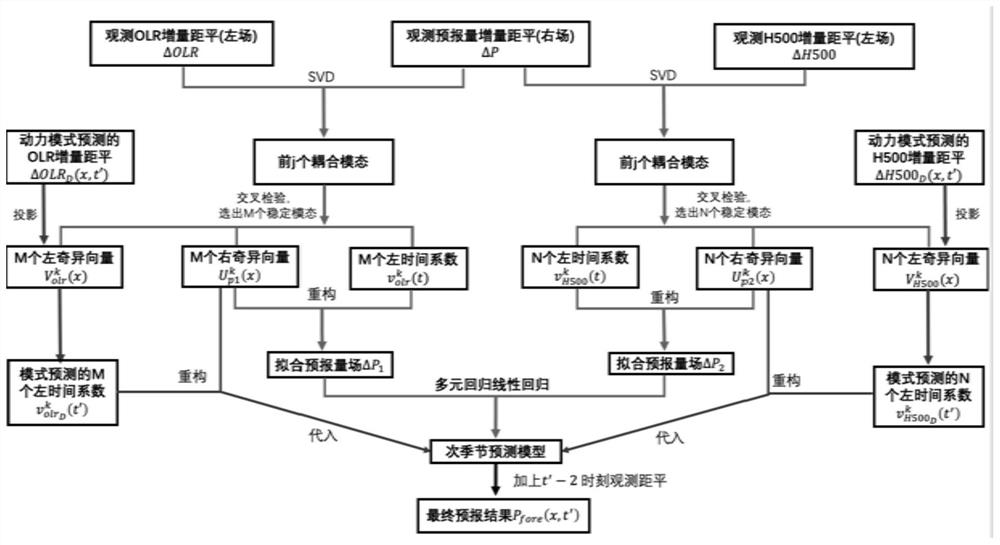Dynamic statistics combined sub-season prediction method based on low-frequency increment space-time coupling
A prediction method and incremental technology, applied in the field of atmospheric science, can solve problems such as low forecasting skills, errors in forecast results, and difficult forecasting skills, and achieve clear physical relationships, improved forecasting capabilities, and improved forecasting capabilities
- Summary
- Abstract
- Description
- Claims
- Application Information
AI Technical Summary
Problems solved by technology
Method used
Image
Examples
Embodiment 1
[0068] A subseasonal forecasting method based on low-frequency incremental spatio-temporal coupling dynamic-statistical integration, such as figure 1 shown, including the following specific steps:
[0069] 1) Select the geopotential height field at middle and high latitudes 500hPa outside the tropics and the OLR field in the tropics at the same time as the forecast data from the observation data as the predictor variable, and calculate the predictor variable and the incremental anomaly of the forecast quantity respectively, where the forecast quantity includes the air temperature Forecast quantity or precipitation forecast quantity; the increment of forecast factor variable and forecast quantity can be pentad, ten days, 15 days, 20 days and 25 days, corresponding to the forecast time limit of one wai, one ten days, 15 days, 20 days and 25 days in advance .
[0070] 2) Using the SVD method, extract the first j high-coupling modes between the incremental anomalies of the left-f...
Embodiment 2
[0076] The optional further design of this embodiment is: in step 1) in this example, the incremental anomaly of the predictor variable and the predictor is calculated according to the following formula:
[0077] δOLR(x,t)=OLR(x,t)-OLR(x,t-2)
[0078] δH500(x, t) = H500(x, t)-H500(x, t-2)
[0079] δP(x,t)=P(x,t)-P(x,t-2)
[0080]
[0081]
[0082]
[0083] Among them, OLR, H500, P are the observed original values of OLR field, 500hPa geopotential height field and forecast quantity, respectively;
[0084] δOLR, δH500, δP are the increments of OLR field, 500hPa geopotential height field and forecast quantity, respectively;
[0085] ΔOLR, ΔH500, and ΔP are the incremental anomalies of the OLR field, the 500hPa geopotential height field, and the forecast quantity, respectively;
[0086] is the average value; x is the spatial dimension of the data, x∈[1,n], n is the total number of spatial dimensions of the data; t is the return time period.
Embodiment 3
[0088] The optional further design of this embodiment is: the specific steps of step 2) in this example are as follows:
[0089]2.1) Divide the reward period t equally to form n subsets, select one of the subsets as the test period, and the remaining n-1 subsets as the training period;
[0090] 2.2) SVD decomposes the incremental anomaly of the right field forecast in the observation data training period, the incremental anomaly of the 500hPa geopotential height field in the left field, and the incremental anomaly of the OLR field, respectively, to obtain the corresponding forecast in the training period The first j coupled modes of the incremental anomaly of 500hPa geopotential height field and the incremental anomaly of the 500hPa geopotential height field, and the first j coupled modes of the incremental anomaly of the forecast quantity and the incremental anomaly of the OLR field; the first j Each coupled mode includes paired left and right singular vectors and paired left...
PUM
 Login to View More
Login to View More Abstract
Description
Claims
Application Information
 Login to View More
Login to View More - R&D
- Intellectual Property
- Life Sciences
- Materials
- Tech Scout
- Unparalleled Data Quality
- Higher Quality Content
- 60% Fewer Hallucinations
Browse by: Latest US Patents, China's latest patents, Technical Efficacy Thesaurus, Application Domain, Technology Topic, Popular Technical Reports.
© 2025 PatSnap. All rights reserved.Legal|Privacy policy|Modern Slavery Act Transparency Statement|Sitemap|About US| Contact US: help@patsnap.com



